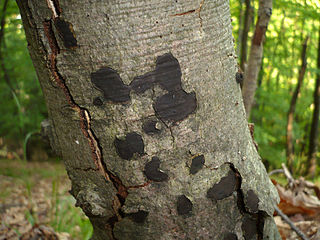
The Amphisphaeriaceae are a family of fungi that is mainly found in parts of New Zealand, South America, Asia and parts of Europe. According to the 2007 Outline of Ascomycota, there were 41 genera placed within the family, although the position of 13 of those genera is uncertain. The 2020 Outline of Fungi and fungus-like taxa severely reduced the family to 4 members.

The Pyronemataceae are a family of fungi in the order Pezizales. It is the largest family of the Pezizales, encompassing 75 genera and approximately 500 species. Phylogenetic analyses does not support the prior classifications of this family, and suggest that the family is not monophyletic as it is currently circumscribed.

The Lecanorales are an order of mostly lichen-forming fungi belonging to the class Lecanoromycetes in the division Ascomycota. The order contains 26 families, 269 genera, and 5695 species.

The Sarcoscyphaceae are a family of cup fungi in the order Pezizales. Members of the Sarcoscyphaceae are cosmopolitan in distribution, found in both tropical and temperate regions.

Tricharina is a genus of fungi in the family Pyronemataceae. The genus has a widespread distribution in temperate regions, and contains 13 species. The anamorph form is Ascorhizoctonia. Tricharina was described by mycologist Finn-Egil Eckblad in 1968.

Chorioactis is a genus of fungi that contains the single species Chorioactis geaster. The mushroom is commonly known as the devil's cigar or the Texas star in the United States, while in Japan it is called kirinomitake (キリノミタケ). This extremely rare mushroom is notable for its unusual appearance and disjunct distribution; it is found only in select locales in Texas and Japan. The fruit body, which grows on the stumps or dead roots of cedar elms or dead oaks, somewhat resembles a dark brown or black cigar before it splits open radially into a starlike arrangement of four to seven leathery rays. The interior surface of the fruit body bears the spore-bearing tissue known as the hymenium, and is colored white to brown, depending on its age. The fruit body opening can be accompanied by a distinct hissing sound and the release of a smoky cloud of spores.

Biscogniauxia is a genus of fungi in the family Xylariaceae. Subtaxa include Biscogniauxia capnodes var. capnodes, Biscogniauxia marginata and Biscogniauxia nummularia, which are plant pathogens. The genus was circumscribed by Otto Kuntze in Revis. Gen. Pl. 2 on page 398 in 1891.
The Microthyriaceae are a family of fungi with an uncertain taxonomic placement in the class Dothideomycetes.

The Rhytismatales are an order of the class Leotiomycetes within the phylum Ascomycota.

Ascozonus is a genus of fungi in the Thelebolaceae family.
Coprobolus is a fungal genus in the family Thelebolaceae. It is a monotypic genus, containing the single species Coprobolus poculiformis. It was first described scientifically in 1970. C. poculiformis has hyaline ellipsoid ascosporess and multispored asci that split open at the apex. It was found on rabbit dung.
Coprotiella is a genus of fungi in the Thelebolaceae family. This is a monotypic genus, containing the single species Coprotiella gongylospora.

Coprotus is a genus of dung-inhabiting "cup fungi"; it has been assigned to the family Thelebolaceae, though doubt has subsequently been thrown on that placement.
Dennisiopsis is a genus of fungi in the Thelebolaceae family.
Leptokalpion is a genus of fungi in the Thelebolaceae family. This is a monotypic genus, containing the single species Leptokalpion albicans. It was first discovered in Thailand in 1977.
Mycoarctium is a genus of fungi in the Thelebolaceae family.
Ochotrichobolus is a genus of fungi in the Thelebolaceae family. This is a monotypic genus, containing the single species Ochotrichobolus polysporus.
Pseudascozonus is a genus of fungi in the Thelebolaceae family. This is a monotypic genus, containing the single species Pseudascozonus racemosporus.

Trichobolus is a genus of fungi in the Thelebolaceae family.

The Rhytismataceae are a family of fungi in the Rhytismatales order. It contains 55 genera and 728 species.












